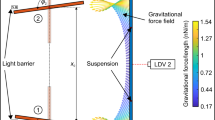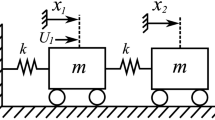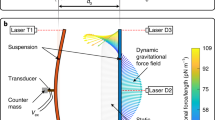Abstract
I HOPE you will allow me to seek information, through your aid, on a subject which is perplexing me a good deal at present. I am engaged in studying a gravimeter designed by the late J. Allan Broun, in which gravity is balanced by the torsion of a single wire; or is intended to be so. As the function of the instrument depends largely on the law of torsion in wires, I have been making experiments to satisfy myself on some points. It is in the results of one of these that I have met with my difficulty. I was using thin brass wire (diam .02), and after stretching it till it broke, twice, I supposed it to be at or near its maximum elasticity, and proceeded to use it in the intended way. At each end of a 6-foot plank I inserted into the edge a 2-inch screw. The wire was fastened upon these so as to get a strain by turning them. The wire was in two pieces, attached to opposite sides of a ring in the middle. By turning this ring the two wires were severally twisted in opposite directions. A straight thick wire passed through the ring, the weight of which afforded a ready means of varying the force necessary to balance the torsion of the wire. My first object was to prove that the force of the latter was, at any rate to some considerable extent, independent of the tension. Suppose that with this arrangement, the wire being horizontal, a balance has been effected when the ring has been turned about the wire as an axis three or four times. What will happen when the wire is further strained? I think it would be a natural expectation (apart from special knowledge) that the weight will rise; on the other hand, a knowledge of the law of torsion teaches (?) that there is no increase of the force sustaining the weight, which therefore will not rise. But who would suppose that, on the contrary, it would sink? Such, nevertheless, is what takes place. I continued increasing the strain, and the weight continued to sink. I had to go on lessening the weight again and again (by shifting the balancing cross-rod), in order to restore the horizontality of the ring; until at last there was scarcely any force of torsion left! To repeat the experiment of course the ring had to receive three or four fresh turns. I did so several times, always continuing, as I thought, to increase the strain. All the time the wire was absorbing the torsion, and did not break. I then thought to try the effect of a high initial torsion. But I did not seem to get any such by turning the ring more than five or six times. I then thought to see how much twisting the wire would bear. Expecting it every instant to break, I counted up to 100 half turns. By this time the wire was quite slack! I added another hundred half turns. The wire was now half an inch longer, without any strain having been kept on it except just enough to keep it straight. I went on twisting. At 218 one wire broke. The other then had only sixteen halt-turns of twist in it, out of the 230 or more received. I afterwards went on twisting, mending each time that the wire broke, till the twist (quite visible under the microscope) amounted to sixteen turns per inch. The length kept on increasing. After breaking, the wire always untwisted one turn in four inches.
This is a preview of subscription content, access via your institution
Access options
Subscribe to this journal
Receive 51 print issues and online access
$199.00 per year
only $3.90 per issue
Buy this article
- Purchase on Springer Link
- Instant access to full article PDF
Prices may be subject to local taxes which are calculated during checkout
Similar content being viewed by others
Author information
Authors and Affiliations
Rights and permissions
About this article
Cite this article
HERSCHEL, J. Wire Torsion. Nature 22, 557–558 (1880). https://doi.org/10.1038/022557e0
Issue Date:
DOI: https://doi.org/10.1038/022557e0
Comments
By submitting a comment you agree to abide by our Terms and Community Guidelines. If you find something abusive or that does not comply with our terms or guidelines please flag it as inappropriate.



